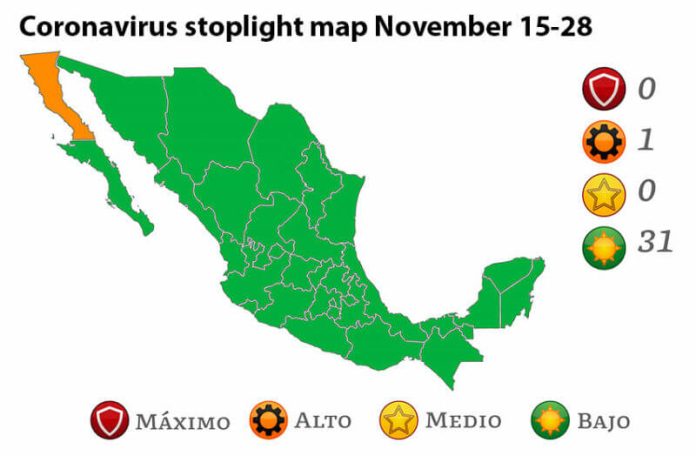All but one of Mexico’s 32 states are now low risk green on the federal government’s coronavirus stoplight map as the third wave of the pandemic continues to decline.
Baja California is the outlier, remaining high risk orange on the new map that takes effect Monday.
Twenty-nine states were green on the previous map, while Guanajuato and Aguascalientes were medium risk yellow. Both those states switched green on the new map, which will remain in force through November 28.
Baja California easily has the highest number of active cases on a per capita basis, just over 80 per 100,000 people, more than double Sonora, which ranks second for current infections with just under 40 per 100,000 inhabitants.
The only other states with more than 30 active cases per 100,000 people are Coahuila, Mexico City, Querétaro and Guanajuato.
Chihuahua, Aguascalientes, Baja California Sur, Yucatán and San Luis Potosí have more than 20 active cases per 100,000 people, while Tabasco, Durango, Nuevo León and Tamaulipas have between 10 and 20. Each of the 17 other states has fewer than 10.
Nationally, reported cases are down 40% this month compared to October. An average of 2,751 new cases per day was reported during the first 14 days of November compared to a daily average of 4,612 in October.
This month’s daily average is 83% lower than the average in August, which was the worst month of the pandemic with more than 500,000 reported cases. The last time average daily case numbers were lower than they currently are was in May when an average of 2,225 per day were reported.
Reported deaths linked to COVID-19 have averaged 199 per day this month, a 43% decline compared to the daily average of 350 in October. The last time the average daily COVID-19 death toll was below 200 was in April 2020 when Mexico was amid the first wave of the pandemic.
The country’s accumulated case tally currently stands at 3.84 million, while the official COVID-19 death toll is 291,147. Both totals are considered vast undercounts, mainly due to Mexico’s low testing rate.
Nevertheless, Mexico ranks 15th in the world for total cases and fourth for fatalities behind only the United States, Brazil and India.
On a per capita basis, Mexico has the 22nd highest death rate in the world with 228 fatalities per 100,000 people, according to data compiled by Johns Hopkins University. Mexico’s fatality rate of 7.6 deaths per 100 confirmed cases is the third highest in the world after those of Yemen and Peru.
For vaccination, Mexico ranks 73rd in the world with 59% of the total population having had at least one shot, according to The New York Times vaccinations tracker. Among adults – the only sector of the population to which vaccines have been widely available – the rate is about 83%, according to the Health Ministry.
Just over 129.8 million shots have been administered to 75.4 million people. More than 63.3 million of those are fully vaccinated. That means approximately 12.1 million people have had one dose of a two-shot vaccine but chose not to get a second one or are still waiting for it.
Authorities in Mexico City – the country’s coronavirus epicenter – have offered first and second shots to all age groups but are currently administering vaccines to people who previously chose not to get vaccinated or were unable to get to vaccination centers.
One such person is Victoria Reyes, a 29-year-old woman with kidney problems who got her first shot late last week.
“What worried me is that I would get some kind of reaction,” she told the newspaper El País when explaining why she didn’t get vaccinated earlier despite losing two family members to COVID.
Reyes said she finally decided to get a shot because she’s now seeing fewer people wearing face masks and following other measures designed to stop the spread of the virus.
“People are not looking after themselves like before and I think that now [that I’m vaccinated] I’ll be more protected,” she said.
El País, which spoke to several people getting shots at the Vasconcelos Library in Mexico City last week, said there were a range of reasons why people had not previously been vaccinated, including fear, distrust of authorities, inability to get to a vaccination center and inadvertently missing their designated vaccination day.
“In my family getting vaccinated was not looked upon well,” said Diana, an 18-year-old student. “They’re anti-vaxxers and they have their theories about what’s being put into you,” she said.
“I was in Veracruz for about three months and I couldn’t come to get my second dose,” said Jesús Ramírez, a 36-year-old security guard.
Some other people showed up at the Vasconcelos Library to try to get an AstraZeneca shot after previously being vaccinated with the CanSino or Sputnik vaccines, which are not certified by the World Health Organization or recognized by United States authorities. Such people cannot currently enter the United States and many other countries, prompting them to seek inoculation with an approved vaccine.
But Yomaya Bezares, a 27-year-old teacher vaccinated with CanSino, told El País that her “mission” to get an AstraZeneca shot had failed, explaining that she was turned away because only second doses of that vaccine were on offer.
With reports from El País
